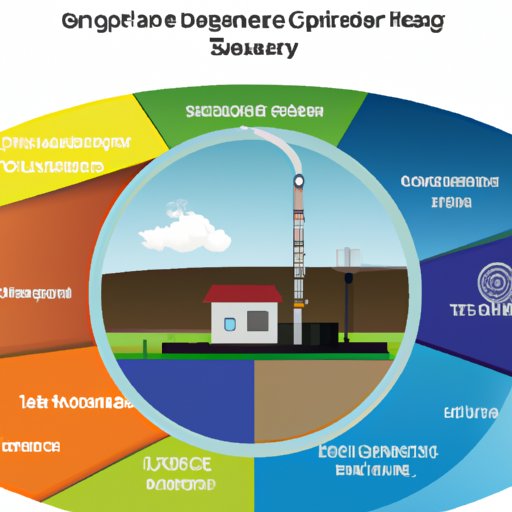
Overview of How Geothermal Energy is Generated
Geothermal energy is a form of renewable energy that has been used for centuries. It is derived from the natural heat found in the Earth’s core, and it can be used to generate electricity and to provide direct heating and cooling. In this article, we will explore how geothermal energy is generated, the benefits it offers, the different components of a geothermal system, the various types of geothermal systems, the cost and efficiency of geothermal energy, the environmental impact, and the future of geothermal energy.
Definition of Geothermal Energy
Geothermal energy is defined as “the thermal energy contained in the rock and fluids beneath the Earth’s surface.” According to the U.S. Energy Information Administration, geothermal energy is produced by “capturing and using the natural heat stored in the Earth’s crust and upper mantle.” This energy can then be used to generate electricity or to provide direct heating and cooling.
Description of How Geothermal Energy is Generated
Geothermal energy is generated through a variety of methods. The most common method is to use a heat pump system, which captures natural heat from the ground and pumps it into an area for heating and cooling. Another method is to use a ground loop system, which uses pipes buried below the surface to exchange heat between the ground and the building. Finally, some geothermal systems use direct-use technology, which takes advantage of hot water reservoirs near the surface of the earth to provide direct heating or cooling.

Exploring the Benefits of Geothermal Power
Geothermal energy offers a number of advantages over other forms of energy. According to a study published in Renewable and Sustainable Energy Reviews, these advantages include:
- Reliability – Geothermal energy is a reliable source of energy that is not subject to fluctuations in weather or availability of fuel.
- Cost savings – Geothermal systems are often more cost-effective than traditional heating and cooling systems.
- Environmental benefits – Geothermal energy does not produce air pollution or greenhouse gases.
In addition to these advantages, geothermal energy also offers economic benefits. According to the U.S. Department of Energy, geothermal systems can reduce energy costs by up to 70%, making them an attractive option for both residential and commercial customers.

Explaining the Different Components of a Geothermal System
Geothermal systems consist of three main components: heat pumps, ground loops, and direct-use systems. Heat pumps capture natural heat from the ground and pump it into an area for heating and cooling. Ground loops use pipes buried below the surface to exchange heat between the ground and the building. Direct-use systems take advantage of hot water reservoirs near the surface of the earth to provide direct heating or cooling.

Examining the Various Types of Geothermal Systems
Geothermal systems can be broken down into three main types: open-loop systems, closed-loop systems, and hybrid systems. Open-loop systems draw water directly from a well or body of water and return it to the same body of water after use. Closed-loop systems circulate a mixture of antifreeze and water through a series of pipes that are buried underground. Hybrid systems combine elements of both open- and closed-loop systems.
Analyzing the Cost and Efficiency of Geothermal Energy
The cost and efficiency of geothermal energy depend on several factors. These include the type of system being used, the size of the system, the local climate, and the installation cost. Generally, geothermal systems have higher upfront costs but lower operating costs due to their increased efficiency. According to the U.S. Department of Energy, geothermal systems can save up to 50% on energy bills compared to traditional heating and cooling systems.
Investigating the Environmental Impact of Geothermal Power
The environmental impact of geothermal energy is minimal compared to other sources of energy. According to the International Renewable Energy Agency (IRENA), geothermal energy produces significantly fewer carbon emissions than fossil fuels. In addition, there is no risk of air or water pollution associated with geothermal energy production.
Geothermal energy also has the potential to reduce dependence on fossil fuels. According to a study published in the journal Renewable and Sustainable Energy Reviews, geothermal energy has the potential to reduce global dependence on fossil fuels by up to 80%.
Evaluating the Future of Geothermal Energy
The future of geothermal energy looks bright. According to the U.S. Department of Energy, the industry is expected to continue to grow in the coming years as more countries invest in geothermal resources. In addition, advances in technology are making geothermal systems more efficient and cost-effective, further increasing their appeal.
However, there are still challenges that must be addressed. For example, geothermal energy is limited to areas with geothermal resources, meaning that not all locations can take advantage of this form of energy. In addition, drilling for geothermal resources can be expensive and time-consuming. Despite these challenges, geothermal energy remains one of the most promising forms of renewable energy.
Conclusion
Geothermal energy is a sustainable and reliable form of renewable energy that has the potential to reduce dependence on fossil fuels and reduce carbon emissions. It offers a number of advantages over other forms of energy, including cost savings and environmental benefits. Geothermal systems consist of three main components and can be broken down into three main types. The cost and efficiency of geothermal energy depends on several factors, and it has a minimal environmental impact compared to other sources of energy. The future of geothermal energy looks bright, though there are still challenges that must be addressed.
(Note: Is this article not meeting your expectations? Do you have knowledge or insights to share? Unlock new opportunities and expand your reach by joining our authors team. Click Registration to join us and share your expertise with our readers.)
